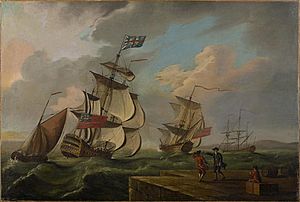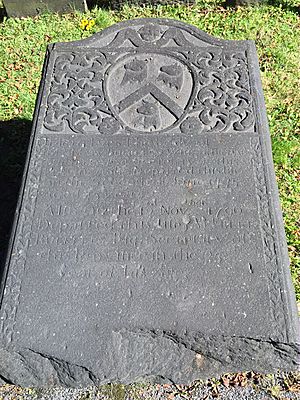John Rous facts for kids
Quick facts for kids
John Rous
|
|
|---|---|

HMS Sutherland sailed by John Rous during the Siege of Louisbourg (1758)
|
|
| Born | 21 May 1702 Charlestown, Middlesex, Massachusetts |
| Died | 3 April 1760 (aged 57) Portsmouth, Hampshire |
| Buried |
St Thomas's Church, Portsmouth
|
| Allegiance | Kingdom of Great Britain |
| Service/ |
Royal Navy |
| Years of service | 1745 – 1760 |
| Rank | Captain |
| Commands held | HMS Shirley HMS Albany HMS Success HMS Sutherland |
| Battles/wars | King George's War |
John Rous (born May 21, 1702 – died April 3, 1760) was a brave sailor. He started as a privateer, which was like a government-approved pirate ship captain. Later, he became an officer in the Royal Navy (Britain's navy).
He played a big part in important wars like King George's War and the French and Indian War. He was also the top naval officer in Nova Scotia during Father Le Loutre's War. His daughter, Mary, married Richard Bulkeley (governor).
Contents
Early Life and Family
John Rous was born in Charlestown, Massachusetts. This was on May 21, 1702. His parents were William Rouse and Mary Peachie.
Fighting in King George's War
John Rous became a privateer during King George's War. This war was part of a bigger conflict called the War of the Austrian Succession. It involved Britain and France fighting in their North American colonies.
In 1740, Rous was a "master's mate" on HMS Ruby. This was a role for an officer's assistant. Later, he commanded his own privateer ship, a 20-gun snow called Shirley. A snow was a type of sailing ship.
In 1744, he led raids against French fishing fleets in Newfoundland. In 1745, he helped lead the New England naval forces. They were attacking Louisbourg, a French fort.
Capturing the Vigilante
On May 19, 1745, Rous helped HMS Mermaid. Mermaid was fighting a large French ship, the 64-gun Vigilante. Rous was the first to help, and the French ship was captured.
For his bravery, Rous was made a third lieutenant on the Vigilante. He then sailed the Shirley to London with important messages. The British Navy bought the Shirley. On September 24, 1745, Rous was made a captain and given command of his old ship. He also took part in the Battle at Port-la-Joye.
Defending Annapolis Royal
In September 1746, the French fleet threatened Annapolis Royal. Captain Rous and the Shirley were ordered to help defend the fort. He worked with Captain Richard Spry to prepare their ships and men. They were ready to help protect the fort if the French attacked.
In 1747, after the Battle of Grand Pré, Rous sailed to the Minas Basin. He helped British forces take back control of the area. His ship, the Shirley, was taken out of service in June 1747. In May 1749, he took command of the 14-gun HMS Albany.
Leading in Father Le Loutre's War
Rous was the most important naval officer in Nova Scotia during Father Le Loutre's War (1749–1755). His main officer was Silvanus Cobb.
Rous helped a lot to protect Halifax and other British settlements. He worked to defeat the French, Acadian, and Mi'kmaq resistance. The British Navy did not send many ships to Nova Scotia. So, Rous used what he had to protect new settlements. These included Halifax, Lunenburg, and Lawrencetown. He also protected older British forts. These were at Canso and Annapolis Royal. He also helped at new forts in Acadian areas. These included Fort Vieux Logis, Fort Edward, and Chignecto.
Under his command were three 14-gun Royal Navy ships. Sometimes, a larger warship from England would join them. He also used several smaller New England ships.
In 1753, Rous became a member of the Nova Scotia Council. This was an important governing group. From 1754 to 1757, he commanded the 20-gun HMS Success. In 1755, he led the naval forces at the Battle of Fort Beauséjour.
French and Indian War Service

Rous continued to serve during the Seven Years' War. He helped prepare for an attack on Louisbourg in 1757. This attack was called off.
However, Rous became captain of the 50-gun HMS Sutherland. He then saw action at the successful siege of Louisbourg in 1758.
Capturing Quebec
He went on to help capture Quebec in 1759. This was known as the Battle of the Plains of Abraham. Rous led Admiral Sir Charles Saunders's fleet up the river. He also helped land troops for the attack, led by General James Wolfe.
Rous returned to England in late 1759. He died in Portsmouth on April 3, 1760. He was buried at St Thomas's Church on April 6, 1760.
Legacy
Several places in Mahone Bay, Nova Scotia, are named after John Rous. These include Rous Island, Rous Point, and Rous Shoal.
See also
- Military history of Nova Scotia
- Military history of the Mi’kmaq People
- Military history of the Acadians

